Feb-14-23
 | | KEG: Something is wrong here.
On its face, this was a short boring draw in which nearly all the pieces were traded off by move 23. But some of the play was bonkers. And when the same players re-played the game with colors reversed two days later (as per the rules in effect at Monte Carlo 1902), that game was also a short draw. I am a hundred twenty-one years removed from this game. But it sure appears that this was a pre-arranged draw. You be the judge: 1. e4 e6
2. d4 d5
3. exd5
Mieses played the exchange variation of the French at least 15 times. Like Morphy--Mieses generally played this variation for a win. But what happened here is not easy to explain. 3... exd5
4. Be3
4. Nf3 or 4. Bd3 are more usual and considered better, but there is nothing suspicious about the text since Mieses played the text regularly. 4... Bd6
4...Nf6 is normal and perhaps best, but there is nothing much wrong with the text. 5. Nc3
5. Nf3 looks better, but--yet again--there is nothing terribly wrong with the text, which left the following position: 
click for larger view5... Nc6?
Huh? This move has never otherwise been played. And small wonder. It at least temporarily loses a pawn. Black gets some counterplay after 6. Nxd5 Be6, but why on earth would Schlechter play 5...Nc6 unless...the players had already agreed to a quick draw with neither side making any serious effort to win. 6. Bd3?
Who turned out the lights? Why didn't Mieses play 6. Nxd5? 6... Nf6
6...Nb4 immediately looks better...unless one is playing moves by rote. Black, of course, was still fine after the text (which belatedly protects the pawn on d5). This all left: 
click for larger view7. Qd2
Either 7. a3 (to prevent Black's Nb4) or 7. Nb5 (to go after the Black Bishop) look indicated. The text is not horrible, but why would Mieses make this choice? 7... Nb4
That certainly looks right.
8. Nb5
Better late than never.
8... NxB+
9. QxN
9. cxN to prevent 9...Bb4+ was probably better, despite the doubled pawns. But at least here I can fathom why Mieses played as he did at this turn. The position was now:
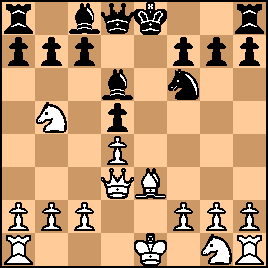
click for larger viewNow, surely, Schlechter would play 9...Bb4+. Right? 9.. 0-0
Nope.
Now, surely, Mieses would capture the d6 Black Bishop. Right? 10. Ne2

click for larger viewAs I will discuss in my next post on this game, the craziness was far from done...from both sides! |
|
Feb-14-23
 | | beatgiant: <KEG> I agree 6. Nxd5 is probably best, but it does not win a pawn, because Black can reply <6...Bxh2> 7. c4 Bxg1 8. Rxg1. White loses the ability to castle kingside, but gets the center and the bishop pair, with probably a slight advantage overall. |
|
Feb-14-23
 | | tamar: Maybe just a bad game score. 5...Nf6 and 6...Nc6 would make sense. |
|
Feb-14-23
 | | KEG: <beatgiant>6...Bxh2 after 6. Nxd5 looks awful. Among other possibilities, White would have a massive edge after 7. Qf3 (your 7. c4 is also strong (though not as good), but your suggested 7...BxN? would be a catastrophe for Black after 8. Bf4!; more likely play would continue 7...Bd6 8. Nc3 with a major advantage for White) Bd6 8. 0-0-0 (or 7...Be6 8. Nc3 Bd6 9. d5 [or perhaps better still, 9. 0-0-0]. Having played over most of Schlechter's tournament and match games, I cannot believe he played 5...Nc6 with the idea of responding to 6. Nxd5 with 6...Bxh2. Perhaps <tamar> is right and this is just a matter of a bad score. But the problems continue for much of the game, as I will discuss in my upcoming post. Either this was a truly rotten score or the players were messing around. Toward the end of the tournament there were at least eight documented instances--one involving Schlechter in which the players agreed in advance to two draws (i.e., including the "replay") without any moves being made. Granted, those all occurred in the final two rounds, but perhaps Mieses and Schlechter cooked up their own way to achieve the same result. I can't prove any of this of course, but I've seen too many of Schlechter's games to believe he could have played as reported in the score of this game. |
|
Feb-14-23
 | | beatgiant: <KEG> You are right about 6. Nxd5 Bxh2 7. c4 Bxg1 <8. Bf4>, which I missed. Black will have to play 7...Bd6 and we get one of your other lines, with advantage to White. But in your other line, Black does have 6. Nxd5 Bxh2 7. Qf3 Bxg1, for now if 8. Bf4 <Bg4> will follow. So it might go 6. Nxd5 Bxh2 7. Qf3 Bxg1 8. Rxg1 Nge7 9. Nxe7 Nxe7 10. 0-0-0 Qd5 11. Qxd5 Nxd5. Again White has an advantage, but it wouldn't be the worst position Schlechter ever defended. |
|
Feb-14-23
 | | KEG: <beatgiant>I agree that after 6. Nxd5 Bxh2 7. Qf3 BxN, my 8. Bf4 doesn't work in light of your 8...Bg4. Good spot! But, in light of your discovery, can't White still get something close to a win in your line with 8. 0-0-0! This might not, as you say, be the worst position Schlechter ever defended, but I doubt Schlechter would have played 5...Nc6 in order to walk into this morass. |
|
Feb-14-23
 | | beatgiant: <KEG> Yes, your <8. 0-0-0> in the line above is a big improvement for White, which again I missed. Black would probably have to straggle into a much worse endgame such as 6. Nxd5 Bxh2 7. Qf3 Bxg1 8. 0-0-0 Nf6 9. Nxf6+ Qxf6 10. Qxf6 gxf6 11. Rxg1. But remember this was 1902. Less than pinpoint accuracy in the openings was the norm in those days. For example see Alekhine vs Schlechter, 1911 where Schlechter was at a big positional disadvantage already around move 10. |
|
Feb-15-23
 | | KEG: <beatgiant>I completely take your point about this being 1902. But it was not just the opening moves here that raised my suspicions. Work was prevented me from up-dating my comments on the Mieses -Schlechter game, but I hope to be back to work on this tonight or in the next day or so. I will take another look at Alekhine--Schlechter from 1911 as you suggest. But I have been reviewing Schlechter's games from 1895 to 1902, and this game against Mieses presents a Schlechter I am unable to recognize. |
|
Feb-16-23
 | | KEG: Post II
10... Re8?!
I fail to understand why Schlechter would leave his dark-square Bishop on d6 where White could exchange it off. Black would have the better chances after 10...Be7 or 10...Bb4+. Now he loses the advantage of having the two Bishops and makes a Bishops of opposite colors ending more likely. Not a bad strategy is Black is hell-bent on playing for a draw. 11. NxB
Of course.
11... QxN
The game was now looking drawish:
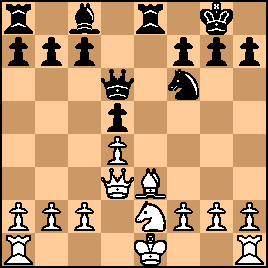
click for larger viewBut there was yet play in the position, and some care was still required (unless the players had already agreed to a draw). 12. h3
12. 0-0 looks clearly best. The text, of course, wasn't any sort of blunder. But... 12... Qb4+
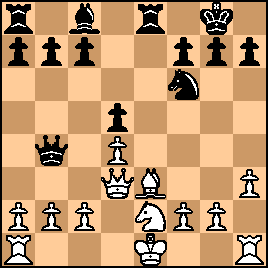
click for larger view13. Nc3?!
Why not simple 13. Qc3 which leaves Black with at most a tiny edge. But now: 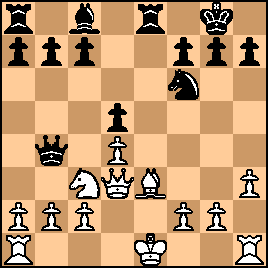
click for larger view13... Ne4?!
Why not simply 13...Qxb2! The Tournament Book denied that Black would derive any edge from 13...Qxb2, but its analysis seems bad: After 13...Qxb2 The Tournament Book's claim that White would obtain a useful attack with 14. 0-0 was based on the belief that Black's best respond would have been 14...Qb6 after which White could play 15. Bg5. But all this falls apart once 14...Bf5! which gives Black something close to a winning position; e.g., 15. QxB [best] QxN after which Black emerges with an extra pawn. White's best play after 13...Qxb2 would be 14. Rb1 Qa3. The Tournament Book is correct that 15. Nxd5 would now be a mistake in light of 15...Qa5+. But White would, though still inferior, would be better advised to play 15. 0-0 with some compensation. 14. 0-0
White would also be OK with 14. 0-0-0 or 14. Qb5. After 14. 0-0 the position was:
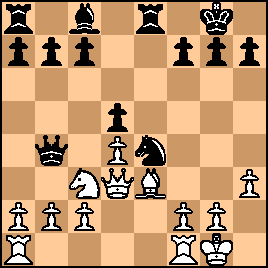
click for larger view14... c6
This seems to abandon any effort to exploit Black's small remaining advantage. Probably 14...NxN followed by 15...Qa4 was the only chance for Black to try for anything beyond a draw. Now...let the exchanges begin:
15. NxN RxN
16. f3 Re8
17. Rae1
A little trap into which Schlechter did not fall: 
click for larger view17... Bd7
Not 17...Qxb2? 18. Bc1! and White wins!
After the text, the players traded off nearly all the pieces and arrived at the draw they both likely sought: 18. b3 Qd6
19. Bf2 Qg6
20. QxQ hxQ
21. RxR+ RxR
22. Re1 RxR+
23. BxR
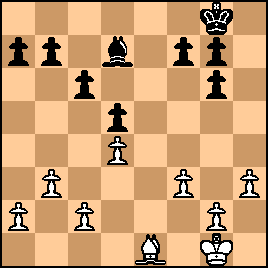
click for larger viewDrawn |
|
Feb-16-23
 | | beatgiant: <KEG> Of course you could be right about the drawing intentions here, but I will now undertake to show a few more examples of inaccurate opening play by Schlechter. One can probably find more, but that could be a subject for a game collection (which might be titled "Schlechter being gentlemanly in the opening"). Schlechter looks in bad trouble around move 10:
Schlechter vs J Mieses, 1909 Vidmar vs Schlechter, 1916 Tartakower vs Schlechter, 1909 Schlechter's opponent looks in bad trouble but Schlechter lets him off the hook around move 10:
Schlechter vs J Mieses, 1907 |
|
| Feb-16-23 | | vonKrolock: The 1916 "Bilguer" (presumably Schlechter himself...) attaches an <!> exclamation mark to <5...Nc6> and adds: <In den Partien Mieses-Mason und Mieses-Gunsberg des erstens Monte Carlo-turniers geschah 5...c6 6.Ld3 Sf6 7.Dd2 nebst 0-0-0 mit gutem Angriff für Weiß> |
|
Feb-16-23
 | | beatgiant: <vonKrolock> And it gives the move as 5...Nc6 and not 5...Nf6 as in <tamar>'s theory above? If so, 5...Nc6 might even have been opening prep. Maybe Schlechter somehow misevaluated the consequences of 6. Nxd5. Serious flaws in opening analysis were a thing in the old days too. Remember, the players then didn't have large game databases, teams of assistants, or computers. Chess history is full of prepared surprises that were later proven to be dubious. |
|
| Feb-21-23 | | vonKrolock: <If so, 5...Nc6 might even have been opening prep.> Yes, so: In page 794. Clearly a preparation directed to this specific game... <Maybe Schlechter somehow misevaluated the consequences of 6. Nxd5.> For me, Mieses was who misevaluated the consequences of 6.Nxd5... When he refused the freshly launched gambit, maybe out of respect to Schlechter's well known analytical capability <Serious flaws in opening analysis> The "Bilguer" gives the notation until 10...Re8, with a <=> mark. Schlechter successfully exchanged in d3, Mieses forgot his long Castles and quick attack plan from games with Black c7-c6 and signaled something with the symmetric exchange in d6. (Yes, computer testing seems to demonstrate that 5...Nc6 is weak... but this wasn't tested over the board before the computers were developed...,) |
|
|
|
|





